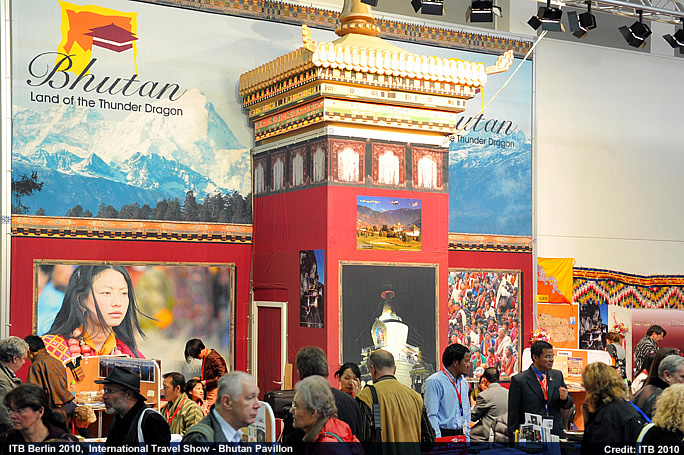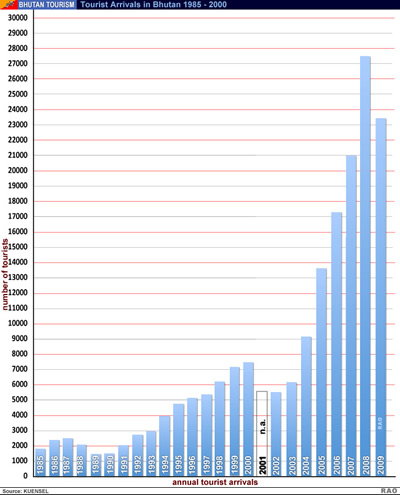|
Tourism
Industry in Bhutan
|
|
Tourism
Industry in Bhutan
|
 |
Bhutan's
Tourism: Trekking |
|
|
|
 |
 
|
GLOBAL TOURISM 2009
|

|
|
Signs of a turnaround, but still two years of lost growth
|
After predicting, in mid-2009, that international tourist arrivals would fall by five percent over the full twelve months of 2009, the World Tourism Organization (UNWTO) upgraded its estimate in January to minus four percent. As confirmed by UNWTO's World Tourism Barometer in late-January, much of the world saw a turnaround in the last four months of 2009, largely due to the low base figures recorded in the same period in 2008. As a result, the final year-end count was better than forecast - in the end, a rather satisfying conclusion to a very challenging year.

|
Nevertheless, we are still talking of two years of lost growth, taking international tourist arrivals to below the magic 900 million mark. And that is not the worst of it - the losses in overnight volume, tourism receipts and industry turnover, not to mention yields, are certain to prove much worse. In absolute value, the overall drop in arrivals masks stark differences between regions. Of the 42 million arrivals that disappeared from 2008's count, Europe accounted for close to 74 percent, or 31 million, as against 8.1 million for the Americas, 3.6 million for Asia and the Pacific, and 2.6 million for the Middle East. Africa, once again, bucked the trend, actually gaining an estimated 2.5 million arrivals in 2009. Arguably, the last 12 to 18 months have been one of the most challenging periods in tourism's history. Both business and consumer confidence were significantly affected, especially with the continuing uncertainties about unemployment and other factors such as exchange rates, the availability of credit, and fears over the H1N1 influenza virus.
 |
|
The region to watch in 2010… Famously, Asia is leading the world out of the economic downturn, and it can also be said to be leading the tourism industry out of the downturn. The turnaround in Asia in the second half of 2009 was dramatic. But the focus remains very much on travel within the region, and the spin-off for the rest of the world has been limited. Arrivals in Asia Pacific fell by nearly seven percent in the first half of 2009, stabilised in the third quarter and rose by an estimated five percent in the last quarter; overall they are estimated to have fallen by two percent in 2009. But the recent results for individual countries, and even sub-regions, varied - and not always in the manner that might have been expected.
Southeast Asia did best by a wide margin, with an eleven percent increase in Q4, bringing the total for the year marginally into positive territory. In Northeast Asia, arrivals rose only three percent in Q4, so the total for the year was still down three percent. |
|
In South Asia they were up only one percent in Q4, and the total for the year was minus four percent. In Oceania, arrivals in Q4 increased three percent, bringing the decline for the full year down to less than two percent. Common factors throughout much of the region, UNWTO said, were a recovery in export business (always a good sign for international business travel) and intensive efforts by governments to encourage consumer spending, as a counterweight to the earlier collapse in exports (efforts which bolstered leisure travel both directly and indirectly, by maintaining consumer confidence in employment and earnings). Whereas in many ‘western' countries governments have been preoccupied with supporting their financial sectors, in Asia they have been freer to support their economies more directly, including (in some cases) increased support for tourism promotion. Another common factor in the fourth quarter of 2009 was a sudden fading in concerns in the region about the H1N1(A) flu epidemic, which many consider (with hindsight, of course) to have been somewhat hysterical.
A more mixed outlook for Southeast Asia The rapid growth of arrivals in Southeast Asia in recent months is due more to the circumstances of individual countries than to general trends, UNWTO said, although many industry stakeholders stress the optimism generated by the early signs of recovery in the world economy.
In Thailand (-7%, but with strong double-digit increases from September), it is related to the greater social and political stability in recent months, which is allowing the ground lost last year to be regained. The confidence of potential travellers to the country is returning, hotels and scheduled airlines have reduced their prices and low-cost carriers have increased their services. All this has been having positive spill-over effects on travel to Cambodia and Lao PDR, because so much travel to these countries is routed through Thailand.
Lao's international profile as a destination is rising and the Southeast Asia Games were held in Vientiane in 2009. But the economic and travel industry crisis in Vietnam continues: arrivals were down twelve percent in 2009, with few signs of improvement. Hotel occupancy rates were said to be very low, driving down prices. Indonesia is bidding to become a new ‘tiger economy' and arrivals were quite steady through the first ten months of 2009, rising by 1% overall - in spite of the occasional natural or man-made disaster (another earthquake in Java and yet another series of bombs in Jakarta).
Earlier in the year Malaysia looked vulnerable to the economic downturn and the fears about the flu epidemic, but arrivals continued to grow and there were large double-digit increases in September to November, so arrivals from January through November months were up eight percent. As an international financial centre and trade entrepôt, Singapore was more exposed to the crisis and arrivals fell by six percent in the same period.
The Philippines and Papua New Guinea had to contend with some civil unrest and unusual typhoon patterns, which brought extraordinary volumes of water and strong winds on unpredictable travel paths, resulting in loss of lives, extensive damage to property and infrastructure, cancellations of international flights and damage to the destinations' reputations. Sri Lanka's recovery boosts South Asia's performance The recent improvement in arrivals in South Asia also appears to be due to the special circumstances of individual countries. UNWTO figures show that arrivals in Sri Lanka plunged in 2007, 2008 and the first five months of 2009 as the war reached its climax, but rebounded in the second half of the year, with monthly increases ranging up to 35 percent.
Arrivals in the Maldives fell by ten percent in the first half of the year as the UK, German, Italian and Japanese markets suffered, but stabilised in Q3 and began to rise quite strongly in Q4, with particular emphasis on the Chinese and Middle East markets. Arrivals in Nepal have been increasing consistently since April.
Overall arrivals in Bhutan the first nine months of 2009 were down four percent. No recent figures are available for Pakistan and Bangladesh, but arrivals in Iran appear to have been holding up well, though the monthly figures are erratic. Arrivals in India (which account for half of the total in South Asia) have been affected by a succession of terrorist attacks and by fears about the spread of the flu epidemic in the country. After falling sharply in Q1, they stabilised in Q2 and then declined again in Q3. Available figures for October and November look slightly better, but the trade reports continued weakness in hotel occupancy rates and other ground prices. However, domestic tourism, on which the Ministry of Tourism has been concentrating its promotional efforts, and tourism in the southern states are said to be doing relatively well.
Source: ITB Berlin, March 2010 |
 |
top
|





